City and Suburban
THE controversy about what sort of new packing cases, miscalled towers, arc to be put up in the City of London has been enlivened by the design for a twenty-seven storey building published in The Times. This scheme is largely financed by Mr. Gore and is nothing to do with the scheme for the whole area, known as New Barbican, being considered by a committee under Sir Gerald Barry recently cold- shouldered by the Court of Common Council of the City of London. Why is there this sudden brisk business in so-called towers for the City ? There are three reasons. One is the present muddle-headed theory about 'open- planning.' This insists that the street frontage be set back so that people are forced to build high on their remaining land, in order to recover lettable floor space. The theory entirely Ignores the idea of a street as a street and produces such buildings as the Underground building in Broadway, West- minster, and Bucklersbury House., The second reason for the popularity of up-ended packing cases is that they are fine advertisements for their promoters. The third, and most Insidious, is that it is old-fashioned to be otherwise. ' Towers ' are 'contemporary.' • The truth is that architecture is either good or bad, not ' contemporary ' or old-fashioned. It depends, as it always has done, on plan, texture, and proportion, and in this country, and in London particularly, on outline. A packing case as high as St. Paul's, such as that proposed at the Barbican. Inight not look too bad, if it were the right colour and texture, in Morocco or the south of France where bright colours and huge slabs of contrasting light and shade can be an adornment to the landscape. But London is Usually mi ,ty grey, suited to uneven outlines, to mouldings and pinnacles and domes and gently hollowed caverns for light and shade. This treatment of the London skyline was understood by all architects until lately, the last successful piece of skyline treatment being that of Whitehall Court. Waterhouse, its designer, used to make his plans first, then draw his skyline and till in the facades afterwards. If a tower is to be built at the Barbican, skyline must be considered first, and above all, St. Paul's dome and Wren's steeples. It is of course nonsense to make the sweeping statement that Wren's London has gone for ever.
Hitching
How long will service departments go on giving their trainees weekend leave for thirty-six or forty-eight hours and not providing them with adequate transport ? I was driving last week in pouring rain and wind down the Great West. Road through the barren majesty of the Wiltshire Downs, between Marlborough and Caine, where the remote and desolate RAF camp at Yatesbury is situated. The road was full of young RAF men thumbing for lifts. Some of them bound for London had even taken lifts westward beyond Chippenham, in .order to be first in the queue of hitch-hikers trying to stop London- bound cars. I gave three such wise men a lift to Chippenham for that purpose myself. It seems cynical of the RAF authorities to give leave without transport and to throw their luckless men on the diminishing charity of private motorists.
Threatened With Closure
. Railway lovers will be pleased to know that there are two voluntary societies advocating the saving of branch lines. The first established was the Railway Development Association. The second is The Society for the Reinvigoration of Unremunerative Branch Lines in the United Kingdom. Both recognise that buses are no substitute for trains when people have heavy .luggage or bicycles or prams. Both advocate the use of railcars the, running of trains at convenient times and more of them. The latter Society has produced a poster which says, DON'T STOP YOUR TRAIN SERVICE—TRAVEL BY IT I' together with the name of the line in the district threatened. The first of these posters I have seen says. The Cambridge to Mildenhall Branch Line is Threatened with Closure.' ft will








































 Previous page
Previous page